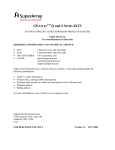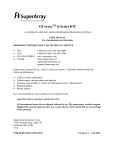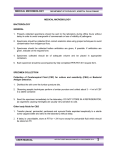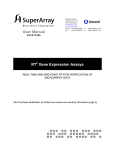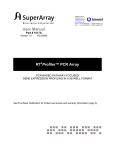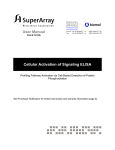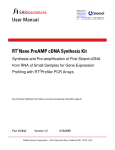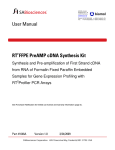Download Oligo GEArray User Manual
Transcript
User Manual BIOMOL GmbH Waidmannstr. 35 22769 Hamburg [email protected] www.biomol.de Phone: +49-40-8532600 or Fax: +49-40-85326022 or 0800-2466651 (D) 0800-2466652 (D) Part # 1004 Oligo GEArray® Microarrays Adhesion Molecules Microarray PATHWAY-SPECIFIC GENE EXPRESSION PROFILING SYSTEMS See Purchaser Notification for limited use license and warranty information (page 4). Oligo GEArray® User Manual Version 1.5 3/4/2005 2 Oligo GEArray® Microarrays PATHWAY-SPECIFIC GENE EXPRESSION PROFILING SYSTEMS USER MANUAL ORDERING INFORMATION AND TECHNICAL SERVICE • • • • TEL: FAX: ON-LINE ORDER: E-MAIL: 0800-2466651 (Germany); +49-40-8532600 0800-2466652 (Germany); +49-40-85326022 www.biomol.de [email protected] (to place an order) [email protected] (for technical support) You may place orders by phone, fax, e-mail or from our website. Each order should include the following information: • • • • • Your contact information (name, phone, email address) Product name, catalog number and quantity Purchase order number or credit card information (MasterCard) Shipping address Billing address For more information, visit us at http://www.biomol.de SuperArray Bioscience Corp. 7320 Executive Way, Suite 101 Frederick, MD 21704 USA 0800-2466651 Technical Support +49-40-853260-23/-27/37 [email protected] www.biomol.de www.superarray.com Oligo GEArray® User Manual Version 1.5 3/4/2005 3 CONTENTS I. Introduction 4 II. Materials Provided 7 III. Additional Materials Required 7 IV. Oligo GEArray® Assay Protocol A. RNA Purification B. cRNA Labeling and Synthesis C. Hybridization D. Chemiluminescent Detection E. Image and Data Acquisition and Analysis 8 9 9 11 13 Troubleshooting Guide 14 V. LIMITED PRODUCT WARRANTY FOR GEARRAY® PRODUCTS This product is intended for research purposes only and is not intended for diagnostic purposes or for human use. This warranty limits our liability to replace this product in the event the product fails to perform due to a physical manufacturing defect but not due to an inability to validate by an independent method any results obtained using this product. SuperArray Bioscience Corporation makes no other warranties of any kind, expressed or implied, including without limitation, warranties of merchantability or fitness for a particular purpose. SuperArray Bioscience Corporation shall not be liable for any direct, indirect, consequential or incidental damages arising out of the use, the results of use or the inability to use this product. Warranties are subject to change at any time without notice. NOTICE TO PURCHASER THE PURCHASE OF GEARRAY PRODUCTS INCLUDES A LIMITED, NONEXCLUSIVE LICENSE TO USE THE MEMBRANES FOR RESEARCH USE ONLY. THIS LICENSE DOES NOT GRANT RIGHTS TO USE THE MEMBRANES FOR REPRODUCTION OF GEARRAY FILTERS, TO MODIFY GEARRAY FILTERS FOR RESALE OR TO USE GEARRAY TO MANUFACTURE COMMERCIAL PRODUCTS WITHOUT WRITTEN APPROVAL OF SUPERARRAY BIOSCIENCE CORPORATION. NO OTHER LICENSE, EXPRESSED, IMPLIED OR BY ESTOPPEL, IS GRANTED. U.S. PATENTS MAY COVER CERTAIN ISOLATED DNA SEQUENCES INCLUDED ON THE GEARRAY. PRESENTLY, IT IS NOT CLEAR UNDER U.S. LAWS WHETHER COMMERCIAL USERS MUST OBTAIN LICENSES FROM THE OWNERS OF THE RIGHTS TO THESE U.S. PATENTS BEFORE USING GEARRAY. 0800-2466651 Technical Support +49-40-853260-23 [email protected] www.biomol.de www.superarray.com Oligo GEArray® User Manual Version 1.5 3/4/2005 4 I. INTRODUCTION The advancement of nucleic acid array technology has made it possible to analyze the expression of multiple genes in a single experiment. However, most commercial gene expression array products, designed to include as many genes as possible, produce a vast amount of data that is overwhelming and difficult to interpret. In addition, the cost of detection equipment and bioinformatics software is often prohibitive. Based on the cDNA GEArray® Q and S Series microarrays (our popular previous generation of pathway-specific gene expression arrays), our new Oligo GEArrays® allow researchers to characterize gene expression associated with a specific biological pathway in a more comprehensive and cost-effective manner. All of the 60-mer oligonucleotides are insured to be gene-specific using a proprietary computer alogrithm. The Oligo GEArrays® are the result of combining superior array design with state-ofthe-art arraying and detection technologies. They are easy to use, sensitive, economical and accessible for routine use in every research laboratory. The Oligo GEArray® microarray contains from 96 to 440 oligonucleotide probes representing genes associated with a specific biological pathway. The probes are printed on a 3.8 x 4.8 cm nylon membrane with an advanced non-contact printing technology in rows of 8, 12, or 16 columns. The catalog number and a unique barcoded serial number are printed on the reverse side of each membrane for easy tracking and documentation. The Oligo GEArrays® are designed for one-time use only. Each array membrane is packaged, stored and used its own disposable hybridization tube. Arrays can be purchased in any quantity, allowing for a parallel and comparative study of multiple samples. Finally, our web-based completely integrated image and data analysis software, the GEArray Expression Analysis Suite, is designed to help easily and rapidly interpret the microarray results. Features of the Oligo GEArray®: • • • • • • • Use of oligos increases specificity of hybridization events Easy to use with minimal hands-on time Comprehensive collection of genes in a specific pathway Proprietary arraying/detection technology offers high sensitivity Non-radioactive detection No special equipment required Cost-effective for routine use 0800-2466651 Technical Support +49-40-853260-23 [email protected] www.biomol.de www.superarray.com Oligo GEArray® User Manual Version 1.5 3/4/2005 5 Figure 1: Overview of the Oligo GEArray® procedure: 0800-2466651 Technical Support +49-40-853260-23 [email protected] www.biomol.de www.superarray.com Oligo GEArray® User Manual Version 1.5 3/4/2005 6 Figure 2: Appearance of Oligo GEArray® Microarrays DESCRIPTION OF MEMBRANE APPEARANCE: Each Oligo GEArray® nylon membrane array is supplied its own disposable hybridization tube. One side of the membrane, the array printing side, is printed with the oligonucleotide probes in rows containing 8, 12, or 16 spots initially visible as red dots. These dots will fade by the end of the procedure, and this side of the membrane will then appear blank. This side of the membrane should always face the inside of the hybridization tube, and should face your film, or CCD camera during image acquisition. On the reverse or information side of the membrane, every array has a unique barcode and serial number to allow tracking of the array during the course of your experiment. Before starting your experiment, always record the array serial number. 0800-2466651 Technical Support +49-40-853260-23 [email protected] www.biomol.de www.superarray.com Oligo GEArray® User Manual Version 1.5 3/4/2005 7 II. MATERIALS PROVIDED: Oligo GEArray® in disposable hybridization tube III. ADDITIONAL MATERIALS REQUIRED: A. Oligo GEArray Trial Kit OR Oligo GEArray Bulk Kit (GA-009 or GA-014) Contain enough reagent kits to process up to four or twelve microarrays, respectively, including the TrueLabeling-AMP™ Linear RNA Amplification Kit (GA-010), the ArrayGrade™ cRNA Cleanup Kit (GA-012), GEAhyb Hybridization Solution (H-01), and the Chemiluminescent Detection Kit (D-01). B. RNA Isolation Kit Recommendations: For Total RNA, ArrayGrade™ Total RNA Isolation Kit (SuperArray, GA-013) Also for animal tissues, TRIzol® from Invitrogen (Catalog Number 15596-026) Or for mRNA, ArrayGrade™ mRNA Purification Kit (SuperArray, GA-002) C. Target Synthesis and Purification: Other material required from another manufacturer for labeled target synthesis: Biotin-16-UTP: Roche Cat. No. 1388908 (11388908910) OR Enzo Cat. No. 42814 (See the TrueLabeling-AMP™ Linear RNA Amplification Kit User Manual for details.) D. Hybridization and Washing: 1. 20X SSC: Dissolve 175.3 g NaCl and 88.2 g sodium citrate dihydrate into 900 ml H2O. Adjust pH to 7.0 with 1M HCl. Dilute to 1 L with H2O. Store at room temperature. 2. 20% SDS: Dissolve 200 g sodium dodecyl sulfate in 1 L H2O. Heat to 65 °C if necessary to dissolve. Store at room temperature. E. Equipment: Thermal cycler or a water bath or hot block Hybridization oven and cylinders or other means to agitate at high temperature X-ray film (Kodak BioMax Maximum Resolution (MR)) and Scanner OR CCD Imaging Station F. Software: GEArray Expression Analysis Suite: (GA-021 for 3 months, GA-022 for one year) Trizol is a registered trademark of Molecular Research Center, Inc. 0800-2466651 Technical Support +49-40-853260-23 [email protected] www.biomol.de www.superarray.com Oligo GEArray® User Manual IV. Version 1.5 3/4/2005 8 Oligo GEArray® Assay Protocol Note: Wear gloves while performing all steps of this protocol. A. RNA PREPARATION One of the most important factors in successful microarray analysis is the quality of the original RNA sample. RNA should be free of contaminating proteins, DNA, and other cellular material as well as phenol, ethanol, and salts used in the RNA isolation procedure. Impurities lower the efficiency of sample labeling. The RNA must also be intact and full-length. Labeling partially degraded RNA generates relatively short targets lacking sequences upstream of the breaks in the original RNA molecule yielding false negative microarray results. For total RNA isolation from cultured or freshly isolated animal cells, we recommend SuperArray’s ArrayGrade Total RNA Isolation Kit (Catalog Number GA-013). This kit isolates RNA of sufficient quantity and quality for the GEArray from these biological sources. For total RNA isolation from animal tissues, we recommend homogenizing and then performing a phenol/chloroform extraction using the TRIzol® reagent from Invitrogen (Catalog Number 15596-026) prior to proceeding with the ArrayGrade™ Total RNA Isolation Kit protocol. SuperArray Bioscience also offers the ArrayGrade mRNA Purification Kit (Catalog Number GA-002) to obtain messenger RNA of high enough quantity and quality to use with our GEArrays. This kit has been tested using a limited number of human cell lines (HEK-293, HeLa, MCF-7) and mouse tissues (heart, liver, lung, kidney, brain). We do not recommend using this kit to isolate mRNA from whole blood or any blood-derived cell line. Remember, mRNA represents a small fraction of total RNA (less than one percent) and that a GEArray experiment requires ten-fold less mRNA than total RNA. Prepare RNA in RNase-Free H2O (DEPC-treated and autoclaved) at a concentration of at least 0.5 mg/ml for Total RNA or at least 0.1 mg/ml for mRNA. Be sure to use the correct amount of RNA (whether total or messenger) as described in the protocol below. Notes: RNA Quality Control Always check the quality of the RNA preparation before continuing this protocol. The A260:A280 ratio of the RNA (whether total or messenger) should be at least 1.8. Characterization of total RNA samples by denaturing agarose gel electrophoresis should yield sharp (not smeared) 28S and 18S rRNA bands having an intensity ratio of 2:1. Messenger RNA should yield a smear centering around 2-4 kbp on a denaturing agarose gel. Any deviation from these specifications indicates degradation of the RNA sample. In which case, isolate fresh RNA before proceeding with this protocol. 0800-2466651 Technical Support +49-40-853260-23 [email protected] www.biomol.de www.superarray.com Oligo GEArray® User Manual Version 1.5 3/4/2005 9 B. cRNA LABELING AND SYNTHESIS: Conversion of experimental RNA to labeled Target cRNA probe Follow the User Manual for the TrueLabeling-AMP™ Linear RNA Amplification Kit provided with Catalog Numbers GA-009 or GA-010. C. HYBRIDIZATION: Note: To prevent leakage, make sure that the O-ring inside the cap of your hybridization cylinder (that comes with your hybridization oven) is present and intact without any cracks. Also to prevent leakage, always tighten the caps of both your hybridization cylinder and our hybridization tubes containing the arrays. An airtight cylinder will prevent the hybridization tube from leaking. If an extra precaution is desired, you may also seal the hybridization tubes using DuraSeal™ Laboratory Sealing Film (Diversified Biotech Cat. No. DS1-150). Note: The O-ring placed around the end of our hybridization tube opposite the cap allows the tube to sit level inside your hybridization cylinder insuring that all volumes of solutions cover the membrane evenly. 1. Pre-hybridization: Note: Start pre-hybridization step during the last steps of cRNA Labeling and Synthesis. Before starting your experiment, always record in your notebook the array serial number, which contains the array lot number. Pre-wet the array membrane by adding roughly 5 ml of deionized water to the hybridization tube. Screw on the cap hand-tight and allow tube to sit inverted for at least 5 minutes. Warm the GEAhyb Hybridization Solution to 60 °C and invert the bottle several times to allow complete dissolution of the buffer components. Discard the deionized water from the hybridization tube. Add 2 ml of pre-warmed GEAhyb Hybridization Solution and vortex the tube briefly. Be sure the cap of the tube is screwed on hand-tight. Place the tube inside your hybridization cylinder. Two GEArray hybridization tubes will fit inside a standard hybridization cylinder (ID x L = 35 x 150 mm). Screw the cap of your hybridization cylinder on hand-tight. Once heated, check the warm hybridization tubes and cylinders to ensure that they are still sealed hand-tight. Pre-hybridize in your hybridization oven at 60 °C for 1 to 2 hours with continuous agitation at 5 to 10 rpm. However, pre-hybridization may continue for up to 72 hours if necessary. 0800-2466651 Technical Support +49-40-853260-23 [email protected] www.biomol.de www.superarray.com Oligo GEArray® User Manual Version 1.5 3/4/2005 10 2. Hybridization: Note: Labeled cRNA is very sensitive to RNase digestion. Please handle cRNA as carefully as you handle RNA. a. Prepare Target Hybridization Mix: Add 4 to 20 µg of biotin-labeled cRNA target prepared using the TrueLabeling-AMP kit to 0.75 ml of pre-warmed GEAhyb Hybridization Solution. Mix well, and keep the Target Hybridization Mix at 60 °C. Note: We suggest starting with 6 µg of cRNA target. However, this amount may be decreased if the resulting signals are too intense or increased if resulting signals are too weak. Levels of cRNA target above 10 µg may saturate more abundant messages on the Oligo GEArray. b. Discard the pre-hybridization solution from the hybridization tube. Add the Target Hybridization Mix containing the labeled cRNA target to the tube. c. Hybridize overnight at 60 °C with continuous agitation at 5 to 10 rpm. 3. Washing: a. Prepare 5 ml of both Wash Solution 1 and Wash Solution 2 for each Oligo GEArray being processed. Note: Wash Solution 2 is a high stringency wash buffer. Its salt concentration is very critical for good microarray results. Please prepare it with an extra care. Wash Solution 1: 2X SSC, 1 % SDS: Mix 10 ml 20X SSC, 5 ml 20 % SDS, and 85 ml ddH2O. Wash Solution 2: 0.1X SSC, 0.5 % SDS Mix 0.5 ml 20X SSC, 2.5 ml 20% SDS, and 97 ml ddH2O. Allow both Wash Solution 1 and Wash Solution 2 to warm to 60 °C before use. b. Pour the Target Hybridization Mix from the hybridization tube into a clean microcentrifuge tube. Store the mix at -20 °C in case and until you may need to hybridize to another array. (However, be sure to pre-warm it to 60 °C for 2-5 minutes before re-use.) c. Add 5 ml Wash Solution 1 to the hybridization tube. Vortex briefly and then place the tube back into hybridization oven. Wash the membrane at 60 °C with 20 to 30 rpm agitation for 15 minutes. Discard the wash solution. d. Add 5 ml Wash Solution 2 to the hybridization tube. Vortex briefly and then place the tube back into hybridization oven. Wash the membrane for EXACTLY 15 minutes at 60 °C with 20 to 30 rpm agitation. Immediately discard the wash solution. Place the cap back on the hybridization tube to prevent the membrane from drying, and allow it cool to room temperature. Note: Wash Solution 2 is a high stringency wash. Excessive washing of the membrane with Wash Solution 2 may result in a loss of signal. 0800-2466651 Technical Support +49-40-853260-23 [email protected] www.biomol.de www.superarray.com Oligo GEArray® User Manual Version 1.5 3/4/2005 11 D. CHEMILUMINESCENT DETECTION Using the Chemiluminescent Detection Kit (Catalog Number D-01) Note: All of the following detection steps are performed at room temperature and in your hybridization oven. Be sure to turn your oven heat OFF, and allow your hybridization oven and cylinders and our hybridization tubes to cool before continuing. Note: GEAblocking Solution Q and 5X Buffer F may cloud during storage at 4 °C. Warm the solutions to 37 °C and invert the bottles several times to allow any precipitate to completely dissolve. Allow the solutions to sit at room temperature until needed. Also allow CDP-star to sit at room temperature until needed. 1. Blocking the Oligo GEArray: Add 2 ml GEAblocking Solution Q to the hybridization tube and vortex briefly. Incubate for 40 min with continuous agitation at 20 to 30 rpm. 2. Binding of alkaline phosphatase-conjugated streptavidin (AP): a. Prepare 1X Buffer F: Dilute 5X Buffer F five-fold to prepare enough 1X Buffer F. You need 16 ml of 1X Buffer F for diluting alkaline phosphatase-conjugated streptavidin (AP-SA) for 1 to 8 Oligo GEArrays. You also need additional 16 ml of 1X Buffer F for washing each Oligo GEArray b. Prepare Dilute AP-SA Buffer: Dilute AP-SA 1:8,000 into 1X Buffer F. We suggest dispensing volume of AP no smaller than 2 µl. Add 2 µl of AP-SA into 16 ml of 1X Buffer F and invert several times to make 16 ml Diluted AP-SA Buffer, enough for up to 8 Oligo GEArrays. c. Discard the GEAblocking Solution Q from the tube. Add 2 ml Dilute AP-SA Buffer, vortex briefly, and incubate for EXACTLY 10 min with continuous but gentle (5-10 rpm) agitation. 3. Washing: Wash the membrane four times with 4 ml 1X Buffer F for 5 min with gentle agitation. Vortex the tube briefly after each addition of fresh 1X Buffer F. 4. Rinsing: Discard the last wash. Rinse the Oligo GEArray twice with 3 ml Buffer G. (Add 3 ml Buffer G, invert three times, carefully discard the buffer, and repeat.) 0800-2466651 Technical Support +49-40-853260-23 [email protected] www.biomol.de www.superarray.com Oligo GEArray® User Manual Version 1.5 3/4/2005 12 5. Detection: Note: CDP-Star stock solution is very susceptible to degradation by bacteria contamination. Use sterile pipettor tips when dispensing. Add 1.0 ml CDP-Star chemiluminescent substrate to the hybridization tube. Rotate the tubes in your room temperature hybridization oven allowing the membrane to incubate with the CDP-Star for 2 to 5 min. Note: It is very important to have the membrane covered evenly with the substrate. Using forceps, touch the membrane corners to a piece of filter paper to remove excess CDP-Star Solution. Take care not to touch the surface of the array. Do not let the membrane completely dry out. The membrane should be saturated and translucent but should not be dripping. Place the membrane into a plastic sheet protector or into a small plastic zip-lock bag and smooth out any bubbles. 0800-2466651 Technical Support +49-40-853260-23 [email protected] www.biomol.de www.superarray.com Oligo GEArray® User Manual Version 1.5 3/4/2005 13 E. Image and Data Acquisition and Analysis: 1. Image Acquisition Note: Remember the blank side of the array should face your film or CCD camera. Orient the array so that the bar code on the reverse side of the membrane is on the right and the name of the array on the reverse side is on the top as you face it. After the CDP-Star incubation, the GEArray is now ready for image acquisition. The chemiluminescent array image can be captured by a number of means. Imaging stations with a cooled CCD camera work the best. Their advantages include lower image backgrounds and good dynamic ranges. A number of different vendors provide suitable image stations (e.g. Alpha-Innotech, Kodak, and UVP). In the absence of a CCD camera image station, certain types of phosphor imagers also detect the chemiluminescent array image (e.g. Typhon by Amershan Biosciences). Alternatively, the array image can also be recorded using X-ray film and a flatbed desktop scanner. Overall array image intensity varies from day to day and from person to person making an initial prediction of the exposure time difficult. As a general rule, the exposure time for capturing the array image (when using either a CCD camera or a X-ray film) should produce the largest possible dynamic range in the individual signals. In other words, the exposure should obtain the maximal difference between the blank spots with no array signal and the brightest spots with maximal array signal that can be achieved using the medium of your choice. For the first time users, we recommend starting with an initial exposure of 1-2 min on X-ray film or 15-20 min exposure using a CCD camera system. Adjust the exposure time after and based on the initial recording. We recommend collecting the chemiluminescent signal as soon as possible. However, The CDP-Star® substrate reaches peak light emission between 2-4 hr. Thus, there is ample time to collect several images with various exposure settings. 2. Image Analysis and Data Acquisition & Analysis No matter which medium you choose to capture the image, save all images as electronic files in grayscale (8 or 16 bit) and preferably in TIFF format or alternatively in JPEG format. CCD cameras and phosphor imagers usually acquire their images in precisely this format. If using X-ray film, be sure to use the software for your flatbed desktop scanner to convert the image of the film into this format. Use the web-based completely integrated GEArray Expression Analysis Suite to complete your data analysis. Refer to the software’s User Guide for more information and further instructions. 0800-2466651 Technical Support +49-40-853260-23 [email protected] www.biomol.de www.superarray.com Oligo GEArray® User Manual Version 1.5 3/4/2005 14 V. TROUBLESHOOTING GUIDE AND FREQUENTLY ASKED QUESTIONS: RNA quality is crucial to the success of the array. It is important to check your RNA quality. The A260:A280 ratio of the RNA should at least 1.8. Characterization of total RNA samples by agarose gel electrophoresis should yield sharp (not smeared) 28S and 18S rRNA bands having an intensity ratio of 2:1. Messenger RNA should yield a smear centering around 2-4 kbp on a denaturing agarose gel. A smearing of either of the 28S and 18S bands or a decrease in their intensity ratio in total RNA, or a lower molecular weight range for mRNA, or a ratio of A260/A280 less than 1.8 indicates degradation of the RNA sample. In which case, perform your RNA preparation again before proceeding with the array analysis. RNA samples are sometimes contaminated with enzyme inhibitors that can reduce labeling efficiency. A. WEAK OR NO SIGNALS Other than the quality of RNA sample, the following factors may also impair your results. 1. Low RNA sample concentration. If the RNA sample is too dilute, it may not perform well in the assay. The RNA concentration should be at least 0.5 mg/ml for total RNA or 0.1 mg/ml for mRNA. 2. Inhibited cRNA Target Synthesis. a. Total RNA should be dissolved in RNase-free dH2O or TE Buffer (10mM TrisHCl, 1mM EDTA). Be sure that the EDTA concentration does not exceed 1 mM; a high EDTA concentration inhibits cRNA target synthesis. b. Solutions that contain SDS as well as unautoclaved DEPC water will inhibit cRNA target synthesis. c. If CsCl or LiCl were used in the process of total RNA purification, trace amounts of Cs+ or Li+ will inhibit cRNA target synthesis. 3. Improper washing in 0.1X SSC solution. Excessive washing of the membrane in high stringency buffer (0.1X SSC solution) may strip off the hybridized probes. Decrease the washing time. 4. Improper hybridization temperature. Check the actual temperature inside your hybridization oven with a thermometer. The temperature reading on your hybridization oven could be several degrees off calibration, especially for digital readouts. B. HIGH BACKGROUND Other than RNA quality, the following factors may cause high background: 1. Pre-hybridization step incomplete. 2. Inaccurate AP-streptavidin dilution. Since the AP-streptavidin is dissolved in a glycerol containing solution, special caution should be taken when pipeting the small volume of AP-streptavidin. We suggest diluting no less than 2 µl of AP-streptavidin into 16 ml of buffer (a 1:8,000 dilution). The final working AP-streptavidin dilution can also be increased to 1:12,000. 3. Improper incubation time with AP-streptavidin. Incubation can be reduced to 10 minutes or less. 0800-2466651 Technical Support +49-40-853260-23 [email protected] www.biomol.de www.superarray.com Oligo GEArray® User Manual Version 1.5 3/4/2005 15 4. Improper washing temperature conditions. Be sure to use enough Wash Solution 2 during the high-stringency washing step. Also, be sure to wash the Oligo GEArray® membrane at 60ºC with agitation at 20-30 rpm. 5. Biotin contamination in containers or buffers. Milk contains a high amount of biotin. Never use any lab ware that has been used for Western blotting. 7. Over-exposure. Try multiple exposures for various shorter times. 8. Too much total RNA. Reduce the amount of total RNA used for cRNA Target Synthesis. We recommend using roughly 3 µg of total RNA or 50 ng of mRNA. Never use more than 3 µg but no less than 0.1 µg of total RNA. Never use more than 200 ng but no less than 20 ng of mRNA. C. I have performed the pre-hybridization of the array, but my cRNA synthesis efficiency is poor. Can I save the membrane until I try the assay again? Yes. Discard the GEAprehyb from the hybridization tube. Store the damp membrane in its tube at –20 °C indefinitely. Once you define and correct the problem and repeat the RNA isolation and / or cRNA synthesis reaction, repeat the pre-hybridization of the array with fresh GEAprehyb pre-warmed to 60 °C. This same procedure also serves as a good stopping point, if needed. D. How do I prevent leakage of the hybridization tube that you provide? Put the tube in a regular hybridization cylinder (not provided). Close our hybridization tube cap and the cap of your cylinder hand-tight. An airtight cylinder will prevent the hybridization tube from leaking. Also, make sure that the O-ring in the cap of your hybridization cylinder is present and intact without any cracks. We also suggest using DuraSeal, a sealing film from Diversified Biotech (Catalog Number DS1-150, etc.). It seals the hybridization tubes very well. E. Can I strip and re-probe the membranes? The Oligo GEArray® is designed for one-time use only. Stripping and re-probing is not recommended. We found that stripping results by individual users varies widely, and even under the best conditions, 80 percent of the original signal is lost despite the UV-crosslinking of the oligonucleotides to the nylon membrane. Stripping and reprobing may be attempted under extreme circumstances or for troubleshooting purposes, but the subsequent results will not be publication quality. If you have additional questions, please check our website (www.superarray.com) for a more complete listing of Frequently Asked Questions (FAQs), or call our technical support representatives at 0800-2466651 or +49-40-853260-23/-27/-37. CDP-Star is a registered trademark of Applera Corporation or its subsidiaries in the US and certain other countries. 0800-2466651 Technical Support +49-40-853260-23 [email protected] www.biomol.de www.superarray.com Oligo GEArray® User Manual Version 1.5 3/4/2005 16 Oligo GEArray® Microarrays Adhesion Molecules Microarray PATHWAY-SPECIFIC GENE EXPRESSION PROFILING SYSTEMS BIOMOL GmbH Waidmannstr. 35 22769 Hamburg [email protected] www.biomol.de Phone: +49-40-8532600 or Fax: +49-40-85326022 or 0800-2466651 Technical Support +49-40-853260-23 [email protected] 0800-2466651 (D) 0800-2466652 (D) www.biomol.de www.superarray.com
















